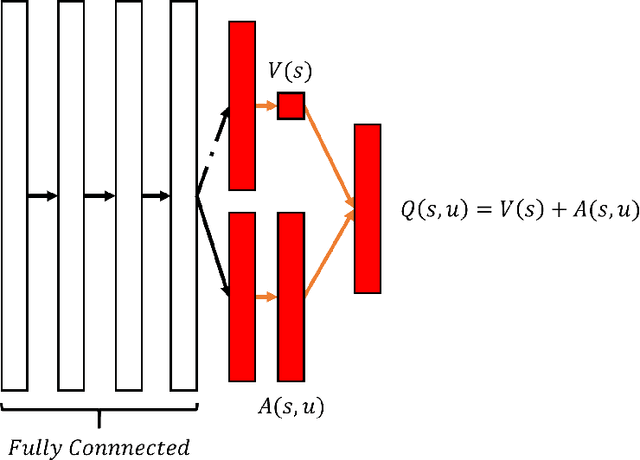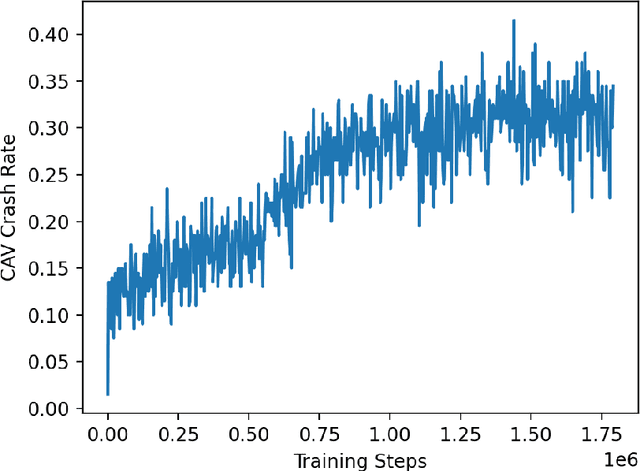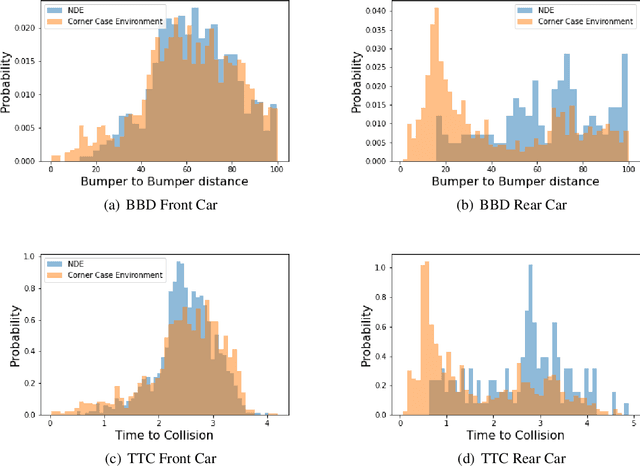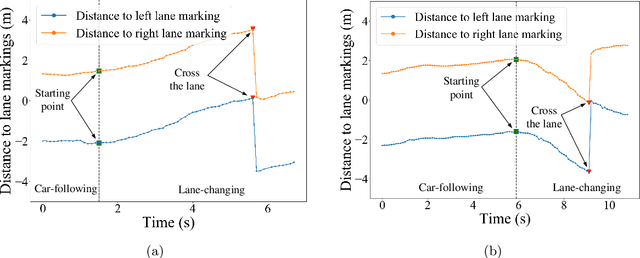Xintao Yan
TeraSim: Uncovering Unknown Unsafe Events for Autonomous Vehicles through Generative Simulation
Mar 06, 2025Abstract:Traffic simulation is essential for autonomous vehicle (AV) development, enabling comprehensive safety evaluation across diverse driving conditions. However, traditional rule-based simulators struggle to capture complex human interactions, while data-driven approaches often fail to maintain long-term behavioral realism or generate diverse safety-critical events. To address these challenges, we propose TeraSim, an open-source, high-fidelity traffic simulation platform designed to uncover unknown unsafe events and efficiently estimate AV statistical performance metrics, such as crash rates. TeraSim is designed for seamless integration with third-party physics simulators and standalone AV stacks, to construct a complete AV simulation system. Experimental results demonstrate its effectiveness in generating diverse safety-critical events involving both static and dynamic agents, identifying hidden deficiencies in AV systems, and enabling statistical performance evaluation. These findings highlight TeraSim's potential as a practical tool for AV safety assessment, benefiting researchers, developers, and policymakers. The code is available at https://github.com/mcity/TeraSim.
CSDO: Enhancing Efficiency and Success in Large-Scale Multi-Vehicle Trajectory Planning
May 31, 2024Abstract:This paper presents an efficient algorithm, naming Centralized Searching and Decentralized Optimization (CSDO), to find feasible solution for large-scale Multi-Vehicle Trajectory Planning (MVTP) problem. Due to the intractable growth of non-convex constraints with the number of agents, exploring various homotopy classes that imply different convex domains, is crucial for finding a feasible solution. However, existing methods struggle to explore various homotopy classes efficiently due to combining it with time-consuming precise trajectory solution finding. CSDO, addresses this limitation by separating them into different levels and integrating an efficient Multi-Agent Path Finding (MAPF) algorithm to search homotopy classes. It first searches for a coarse initial guess using a large search step, identifying a specific homotopy class. Subsequent decentralized Quadratic Programming (QP) refinement processes this guess, resolving minor collisions efficiently. Experimental results demonstrate that CSDO outperforms existing MVTP algorithms in large-scale, high-density scenarios, achieving up to 95% success rate in 50m $\times$ 50m random scenarios around one second. Source codes are released in https://github.com/YangSVM/CSDOTrajectoryPlanning.
Evaluation of automated driving system safety metrics with logged vehicle trajectory data
Jan 03, 2024Abstract:Real-time safety metrics are important for the automated driving system (ADS) to assess the risk of driving situations and to assist the decision-making. Although a number of real-time safety metrics have been proposed in the literature, systematic performance evaluation of these safety metrics has been lacking. As different behavioral assumptions are adopted in different safety metrics, it is difficult to compare the safety metrics and evaluate their performance. To overcome this challenge, in this study, we propose an evaluation framework utilizing logged vehicle trajectory data, in that vehicle trajectories for both subject vehicle (SV) and background vehicles (BVs) are obtained and the prediction errors caused by behavioral assumptions can be eliminated. Specifically, we examine whether the SV is in a collision unavoidable situation at each moment, given all near-future trajectories of BVs. In this way, we level the ground for a fair comparison of different safety metrics, as a good safety metric should always alarm in advance to the collision unavoidable moment. When trajectory data from a large number of trips are available, we can systematically evaluate and compare different metrics' statistical performance. In the case study, three representative real-time safety metrics, including the time-to-collision (TTC), the PEGASUS Criticality Metric (PCM), and the Model Predictive Instantaneous Safety Metric (MPrISM), are evaluated using a large-scale simulated trajectory dataset. The proposed evaluation framework is important for researchers, practitioners, and regulators to characterize different metrics, and to select appropriate metrics for different applications. Moreover, by conducting failure analysis on moments when a safety metric failed, we can identify its potential weaknesses which are valuable for its potential refinements and improvements.
A probabilistic model for missing traffic volume reconstruction based on data fusion
May 06, 2021



Abstract:Traffic volume information is critical for intelligent transportation systems. It serves as a key input to transportation planning, roadway design, and traffic signal control. However, the traffic volume data collected by fixed-location sensors, such as loop detectors, often suffer from the missing data problem and low coverage problem. The missing data problem could be caused by hardware malfunction. The low coverage problem is due to the limited coverage of fixed-location sensors in the transportation network, which restrains our understanding of the traffic at the network level. To tackle these problems, we propose a probabilistic model for traffic volume reconstruction by fusing fixed-location sensor data and probe vehicle data. We apply the probabilistic principal component analysis (PPCA) to capture the correlations in traffic volume data. An innovative contribution of this work is that we also integrate probe vehicle data into the framework, which allows the model to solve both of the above-mentioned two problems. Using a real-world traffic volume dataset, we show that the proposed method outperforms state-of-the-art methods for the extensively studied missing data problem. Moreover, for the low coverage problem, which cannot be handled by most existing methods, the proposed model can also achieve high accuracy. The experiments also show that even when the missing ratio reaches 80%, the proposed method can still give an accurate estimate of the unknown traffic volumes with only a 10% probe vehicle penetration rate. The results validate the effectiveness and robustness of the proposed model and demonstrate its potential for practical applications.
Corner Case Generation and Analysis for Safety Assessment of Autonomous Vehicles
Feb 06, 2021



Abstract:Testing and evaluation is a crucial step in the development and deployment of Connected and Automated Vehicles (CAVs). To comprehensively evaluate the performance of CAVs, it is of necessity to test the CAVs in safety-critical scenarios, which rarely happen in naturalistic driving environment. Therefore, how to purposely and systematically generate these corner cases becomes an important problem. Most existing studies focus on generating adversarial examples for perception systems of CAVs, whereas limited efforts have been put on the decision-making systems, which is the highlight of this paper. As the CAVs need to interact with numerous background vehicles (BVs) for a long duration, variables that define the corner cases are usually high dimensional, which makes the generation a challenging problem. In this paper, a unified framework is proposed to generate corner cases for the decision-making systems. To address the challenge brought by high dimensionality, the driving environment is formulated based on Markov Decision Process, and the deep reinforcement learning techniques are applied to learn the behavior policy of BVs. With the learned policy, BVs will behave and interact with the CAVs more aggressively, resulting in more corner cases. To further analyze the generated corner cases, the techniques of feature extraction and clustering are utilized. By selecting representative cases of each cluster and outliers, the valuable corner cases can be identified from all generated corner cases. Simulation results of a highway driving environment show that the proposed methods can effectively generate and identify the valuable corner cases.
Distributionally Consistent Simulation of Naturalistic Driving Environment for Autonomous Vehicle Testing
Jan 08, 2021



Abstract:Microscopic traffic simulation provides a controllable, repeatable, and efficient testing environment for autonomous vehicles (AVs). To evaluate AVs' safety performance unbiasedly, ideally, the probability distributions of the joint state space of all vehicles in the simulated naturalistic driving environment (NDE) needs to be consistent with those from the real-world driving environment. However, although human driving behaviors have been extensively investigated in the transportation engineering field, most existing models were developed for traffic flow analysis without consideration of distributional consistency of driving behaviors, which may cause significant evaluation biasedness for AV testing. To fill this research gap, a distributionally consistent NDE modeling framework is proposed. Using large-scale naturalistic driving data, empirical distributions are obtained to construct the stochastic human driving behavior models under different conditions, which serve as the basic behavior models. To reduce the model errors caused by the limited data quantity and mitigate the error accumulation problem during the simulation, an optimization framework is designed to further enhance the basic models. Specifically, the vehicle state evolution is modeled as a Markov chain and its stationary distribution is twisted to match the distribution from the real-world driving environment. In the case study of highway driving environment using real-world naturalistic driving data, the distributional accuracy of the generated NDE is validated. The generated NDE is further utilized to test the safety performance of an AV model to validate its effectiveness.
 Add to Chrome
Add to Chrome Add to Firefox
Add to Firefox Add to Edge
Add to Edge